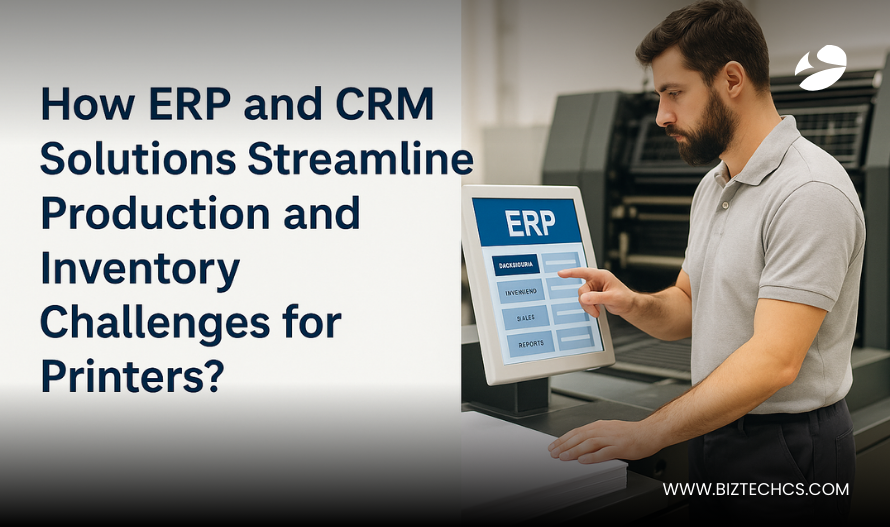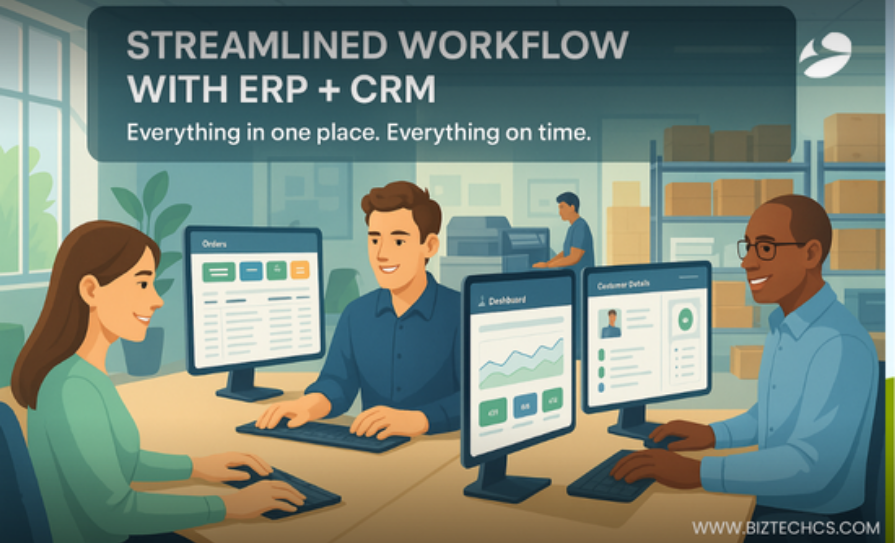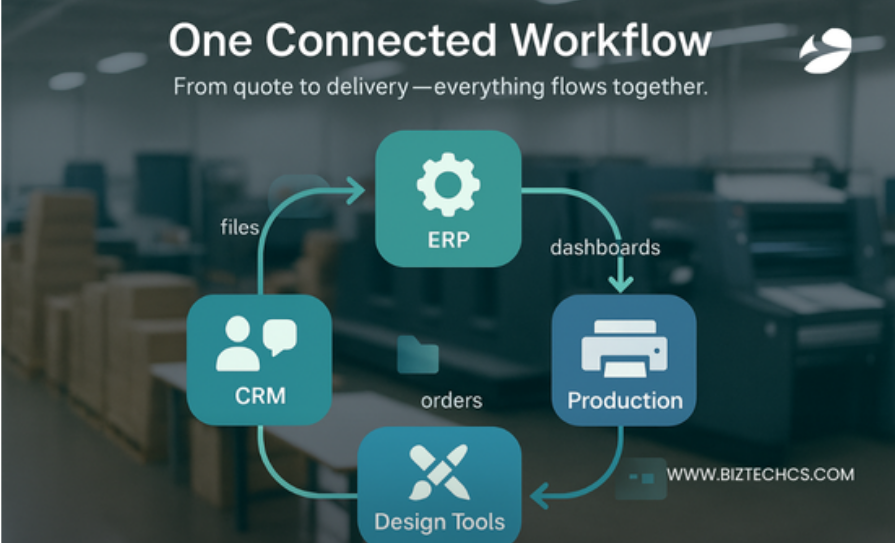How ERP and CRM Solutions Streamline Production and Inventory Challenges for Printers?
5 min read
5 min read
Table of Content

High-volume promotional printing enterprises often handle more than 10,000 custom jobs every single day. Yet many still rely on spreadsheets, emails, and siloed tools to run critical operations. Order specifications might come through sales reps, artwork files might arrive via WeTransfer, and client preferences could remain buried in inboxes.
Now imagine a Fortune 500 client calling with an urgent reprint request: “Same specs as last month’s job, but with the logo we approved two months ago.” On the surface, it’s a simple request. But in reality, the approved artwork could be sitting in a designer’s old email thread, the original order might be hidden in a shared drive folder, and the account manager who handled it could be away. The result? Delays, miscommunication, and costly reprints. And it raises an important question—if a client asked for the exact approved file from two months ago, how quickly can your team deliver it: in minutes or in hours?
This is exactly the type of challenge BiztechCS can solve. BiztechCS can implement an ERP + Odoo CRM solution that becomes a single source of truth for every order, every revision, and every customer touchpoint. No more scattered details—everything will live in one place.
BiztechCS can configure the system so that client specifications, approval histories, and artwork files are centralized and always accessible in real time. That means anyone on the team, at any time, can pick up where another left off with complete clarity.
To streamline collaboration, BiztechCS can develop automated workflows that connect sales, design, production, and dispatch. Instead of teams working in silos or relying on memory, everyone will work from the same accurate, up-to-date information.
Most importantly, BiztechCS will enable complete visibility across the order lifecycle—from the moment a customer requests a quote to the second the job leaves the dispatch dock. That visibility will prevent delays, eliminate errors, and protect client trust.
From our experience, BiztechCS can help high-volume printing companies recognize a critical turning point: once daily orders exceed 1,000, spreadsheets and email chains stop being useful and start becoming liabilities. The earlier you act, the faster you can turn operational chaos into a competitive advantage.
When BiztechCS first walks into a client facility, we often see a pattern we’ve witnessed dozens of times before. The promotional printing company may be processing an impressive 10,000+ custom jobs daily, but their operations are held together by digital duct tape and heroic individual efforts.
Through our assessment, we’ve identified several key challenges that often hinder growth and efficiency in high-volume printing companies.
Customer preferences might reside in someone’s personal email inbox. Artwork approval history could exist only in cloud folders that individuals manage. Previous order specifications may exist only in the memory of the person who handled that job.
One production manager confessed to us: “Sometimes we print with outdated files—not because we want to, but because we honestly can’t tell which version was actually approved. The pressure to deliver on time means we make our best guess and hope it’s right.”
Without central visibility, mistakes multiply exponentially. Teams may print with outdated files simply because they can’t easily identify the latest approved version. Rush jobs often skip approval steps, not out of neglect, but because the process is too cumbersome under tight deadlines. The irony of success in the printing industry is brutal, and BiztechCS sees it repeatedly—companies build their reputation on personal service and attention to detail, but as they scale, the very systems that once helped them thrive start working against them.
Research by McKinsey shows that employees spend nearly 20% of their time searching for internal information instead of creating value (source). For high-volume printing companies, that wasted time quickly compounds into hundreds of hours every week. And when those hours are being spent hunting through inboxes or chat threads, clients are often left waiting on hold. That leads to a difficult question every printing operations manager should ask: how many times this week did your team scramble to find critical information while a client was left waiting for answers?
The transition from small-batch to high-volume printing isn’t just about adding more machines—it’s about fundamentally changing how information flows across your organization.
BiztechCS can implement Odoo so your systems scale with your production, ensuring teams always have immediate access to the latest approvals, artwork, and specifications—without the scramble.
Struggling with scattered information and missed deadlines? BiztechCS can help you eliminate the chaos by centralizing your approvals, specs, and artwork with Odoo ERP + CRM. Say goodbye to the scramble and hello to streamlined operations, better quality control, and satisfied clients.

After witnessing daily chaos, BiztechCS knows exactly what promotional printing companies need: Complete integration from customer quote to delivery dispatch. But BiztechCS also knows transformation should happen in phases—without disrupting daily output.
We can design a phased integration approach that will optimize each part of your workflow and seamlessly connect them for long-term success.
We can roll out Odoo CRM, specifically tailored for printing workflows. Every quote, customer change request, and order communication will be automatically logged and accessible.
Each order can be systematically tagged with:
We can also build client-specific quick reorder dashboards to transform efficiency.
Odoo Consultant Tip: Odoo CRM becomes a game-changer when workflows are configured for printing. It doesn’t just log data—it builds a foundation for repeatable, error-free service.
Once the customer foundation is solid, BiztechCS can integrate Odoo ERP to handle:
With CRM and ERP fully connected, BiztechCS can implement:
In fact, organizations that implemented ERP–CRM integration saw operational efficiency improve by 85%, and response times were reduced by 32% —demonstrating the powerful impact of streamlined, connected workflows (ResearchGate).
Odoo Consultant Tip: High-volume printing doesn’t need speed alone—it needs an error-proof flow from client approval to dispatch. That’s possible without sacrificing the personal attention that built your reputation
.

The core ERP and CRM integration is just the start. We can extend value with:
We can connect your design workflows directly to the job management system. When designers save approved artwork, it can automatically attach to the correct order with version control. No more hunting through folders or wondering which file was final.
We can provide real-time shipping rates and tracking integration so customers receive automatic updates from approval to delivery. The days of clients calling to ask “Where’s my order?” can become history.
We can build B2B ordering portals where major clients can:
We can make financial data flow seamlessly from order creation to final payment, eliminating duplicate data entry and improving cash flow visibility.
Odoo Consultant Tip: The magic happens when systems talk to each other automatically. When a client approves artwork, that approval should instantly update the production schedule, notify relevant teams, and trigger the next workflow step—without human intervention.
Curious how design tools, shipping APIs, client portals, and smart automation could work together to transform your print operations?
Six months after integration, companies we work with can transform from daily chaos to operating like precision instruments.
Instead of beginning each day with information scrambles, teams can start with complete visibility. Production managers can see daily priorities sorted by delivery commitments and client importance. Designers can have queues of approved jobs ready to process. Sales reps can update clients without internal calls.
With integrated systems, clients can receive automatic updates as jobs progress. No more status calls—clients already know exactly where their orders stand. When issues arise, your team can identify affected orders and notify clients before they even realize a problem exists.
Quality Issues Become Rare Events
With every approval, revision, and specification tracked in a central system, quality issues can drop dramatically. The system can prevent accidental use of outdated files. Client specifications won’t get lost because they are permanently attached to every work order.
Poor data quality can have serious—and expensive—consequences. In fact, consulting firm Gartner estimates that it costs organizations an average of $12.9 million every year (source). For high-volume printing companies, that kind of loss can mean compromised efficiency, stressed teams fixing preventable mistakes, and client trust eroded by repeated errors.
That’s exactly where BiztechCS can step in—by making Odoo your single source of truth, BiztechCS can reduce those losses dramatically. With a unified system for approvals, job specs, artwork, and client history, your team always works from accurate, centralized information—so misprints and data confusion become things of the past.
With real-time visibility into production capacity and priorities, rush orders can be accommodated without chaos. The system can automatically identify which jobs can be delayed slightly and which machines have capacity for urgent work.
The transition from scattered, error-prone workflows to a streamlined, unified system is within your reach. By implementing Odoo ERP and CRM, BiztechCS can help you eliminate bottlenecks, reduce costly mistakes, and give your team the tools to scale efficiently.
Don’t let fragmented processes hold your business back. Invest in a future-proof solution that drives growth, improves client satisfaction, and enhances productivity.
Curious how your printing business could move from daily chaos to error-free, streamlined operations? Let BiztechCS show you what’s possible when smart automation meets client-first workflows. Reach out to discuss how we can align Odoo ERP and CRM with your growth ambitions.
All product and company names are trademarks™, registered® or copyright© trademarks of their respective holders. Use of them does not imply any affiliation with or endorsement by them.

Artificial Intelligence (AI)
65
By Nandeep Barochiya

Odoo
100
By Uttam Jain

Odoo
57
By Uttam Jain